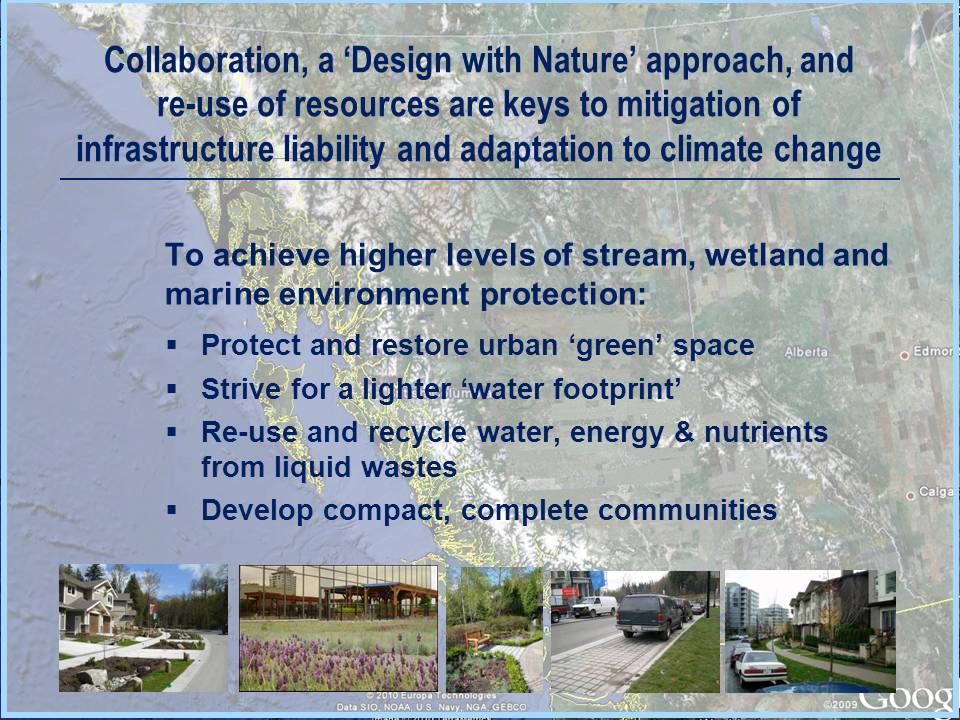Sustainable Service Delivery: Comox Valley Local Governments Release Program Details for 2011 Learning Lunch Series
Note to Readers:
Commencing in 2007, the four local governments in the Comox Valley and the Comox Valley Land Trust have been collaborating to advance a ‘regional team approach’ under the umbrella of CAVI-Convening for Actlon on Vancouver Island. In 2011, the Town of Comox is the host for the Comox Valley Learning Lunch Seminar Series, a program for continuing education. Seminars will start at 10am and finish at 3pm on these dates:
The target audience is land use and infrastructure professionals in the local government and development sectors. The following article is the first in a weekly series that foreshadow program content. This first article provides preliminary information about the vision and desired outcomes for the 2011 Series.
To download a PDF version, click on Comox Valley Local Governments Showcase A Regional Response to Infrastructure Liability: Program Details for 2011 Comox Valley Learning Lunch Seminar Series. To download a PDF of the image below, click on the 2011 program at a glance.
The 2011 Series is open to local governments from beyond the Comox Valley. Registration will be capped at 45. First priority will be given to those from the Comox Valley.

2011 Theme: A Regional Response to Infrastructure Liability
 “History shows that local governments are very good at planning ahead, but not-so-good at looking ahead – for example: The initial capital cost of municipal infrastructure is about 20% of the life-cycle cost. The other 80% is an unfunded liability, and is increasing year after year,” states Glenn Westendorp, Public Works Superintendent with the Town of Comox. He is Chair of the 2011 Series.
“History shows that local governments are very good at planning ahead, but not-so-good at looking ahead – for example: The initial capital cost of municipal infrastructure is about 20% of the life-cycle cost. The other 80% is an unfunded liability, and is increasing year after year,” states Glenn Westendorp, Public Works Superintendent with the Town of Comox. He is Chair of the 2011 Series.
The Problem is the Unfunded Liability
 “The unfunded ‘infrastructure liability’ is a driver for local governments to consider longevity, focus on what happens after developers hand-off municipal infrastructure, get it right at the front-end, and prepare for the future. Climate change is part of the liability equation – adaptation has level-of-service implications for infrastructure,” continues Derek Richmond, Manager of Engineering with the City of Courtenay.
“The unfunded ‘infrastructure liability’ is a driver for local governments to consider longevity, focus on what happens after developers hand-off municipal infrastructure, get it right at the front-end, and prepare for the future. Climate change is part of the liability equation – adaptation has level-of-service implications for infrastructure,” continues Derek Richmond, Manager of Engineering with the City of Courtenay.
 “Thus, the unifying theme for the 2011 Comox Valley Learning Lunch Seminar Series is this: Water sustainability is more likely to be achieved when land use planning and climate change adaptation are integrated with infrastructure asset management,” adds Judy Walker, Planner with the Village of Cumberland.
“Thus, the unifying theme for the 2011 Comox Valley Learning Lunch Seminar Series is this: Water sustainability is more likely to be achieved when land use planning and climate change adaptation are integrated with infrastructure asset management,” adds Judy Walker, Planner with the Village of Cumberland.
The Solution is a Life-Cycle Approach
 “Tackling the unfunded infrastructure liability involves a life-cycle way of thinking about infrastructure needs and how to pay for those needs over time. This holistic approach is described as Sustainable Service Delivery,” emphasizes Michael Zbarsky, Manager of Transit and Sustainability with the Comox Valley Regional District.
“Tackling the unfunded infrastructure liability involves a life-cycle way of thinking about infrastructure needs and how to pay for those needs over time. This holistic approach is described as Sustainable Service Delivery,” emphasizes Michael Zbarsky, Manager of Transit and Sustainability with the Comox Valley Regional District.
 “The link between infrastructure asset management and the protection of a community’s natural resources is emerging as an important piece in Sustainable Service Delivery. By ‘designing with nature’, a local government could make a very strong case for having a higher level of service, at a lower life-cycle cost, with ‘assets’ that appreciate, not depreciate,” concludes Jack Minard, Executive Director of the Comox Valley Land Trust.
“The link between infrastructure asset management and the protection of a community’s natural resources is emerging as an important piece in Sustainable Service Delivery. By ‘designing with nature’, a local government could make a very strong case for having a higher level of service, at a lower life-cycle cost, with ‘assets’ that appreciate, not depreciate,” concludes Jack Minard, Executive Director of the Comox Valley Land Trust.
To Learn More About ‘Infrastructure Liability’
The Winter 2011 issue of the Asset Management BC Newsletter has an article that connects the dots between watershed-based planning and infrastructure management. To access the article, click on Integrated Rainwater Management: Move to a Levels-of-Service Approach to Sustainable Drainage Infrastructure. 
Posted March 2011


